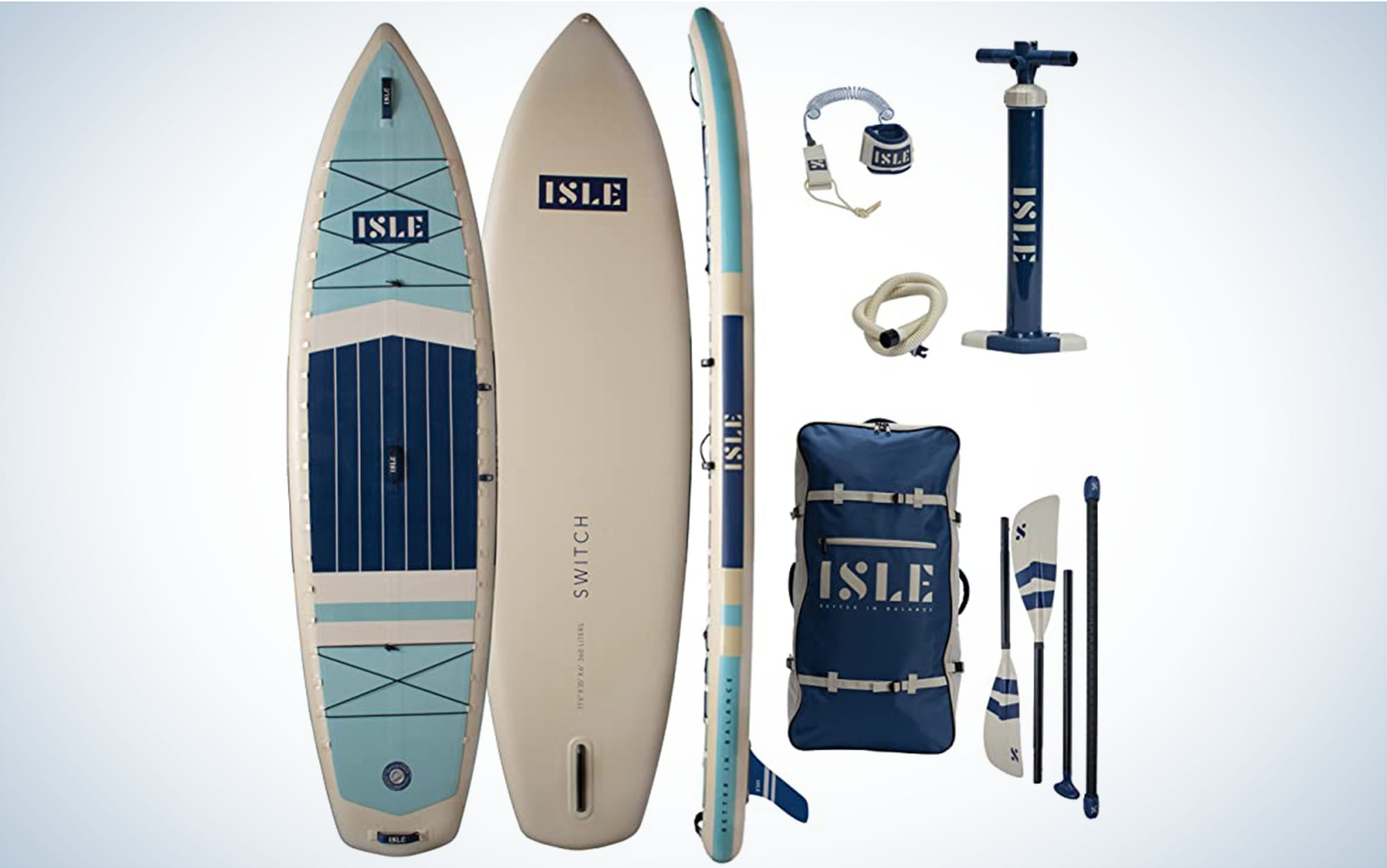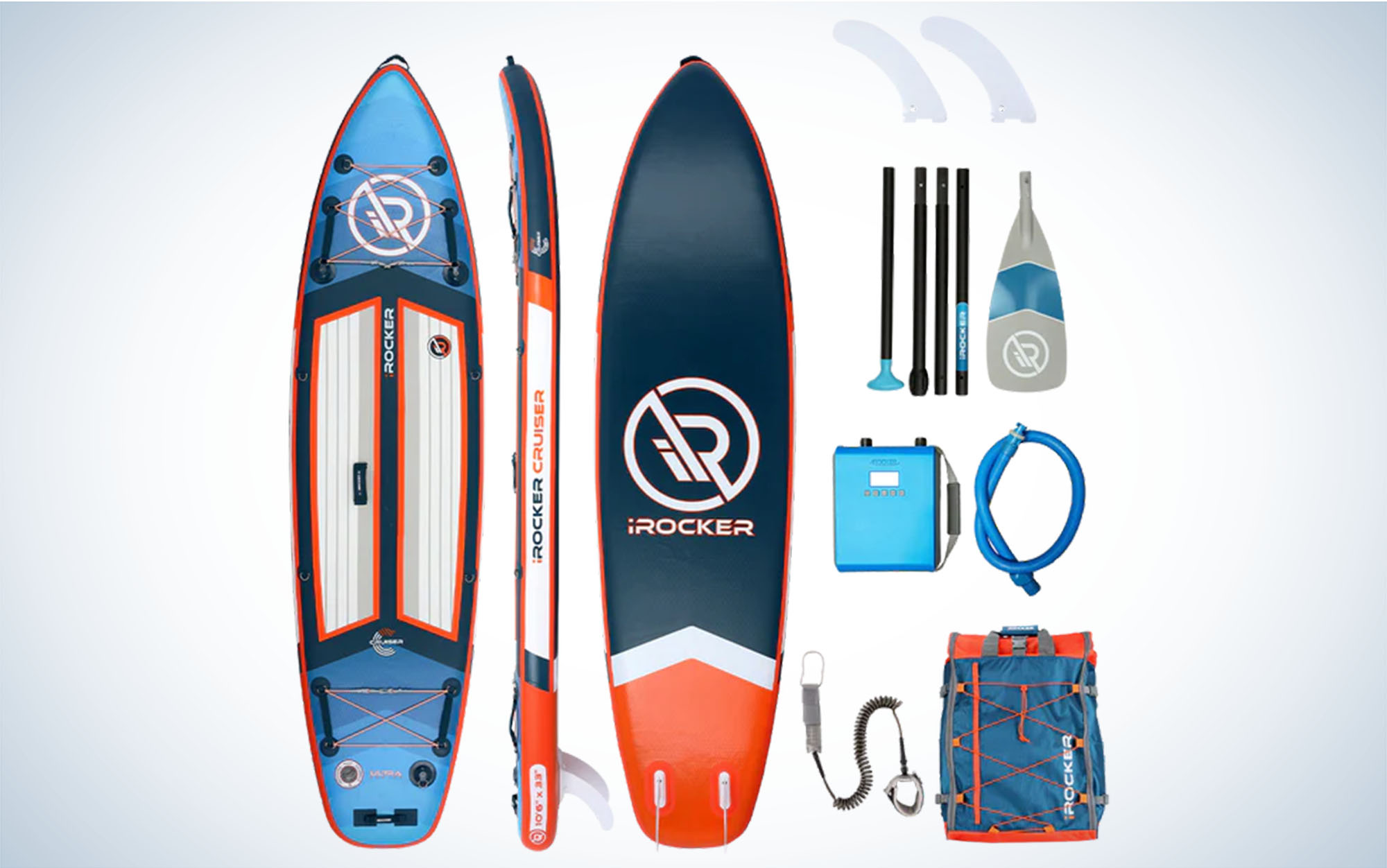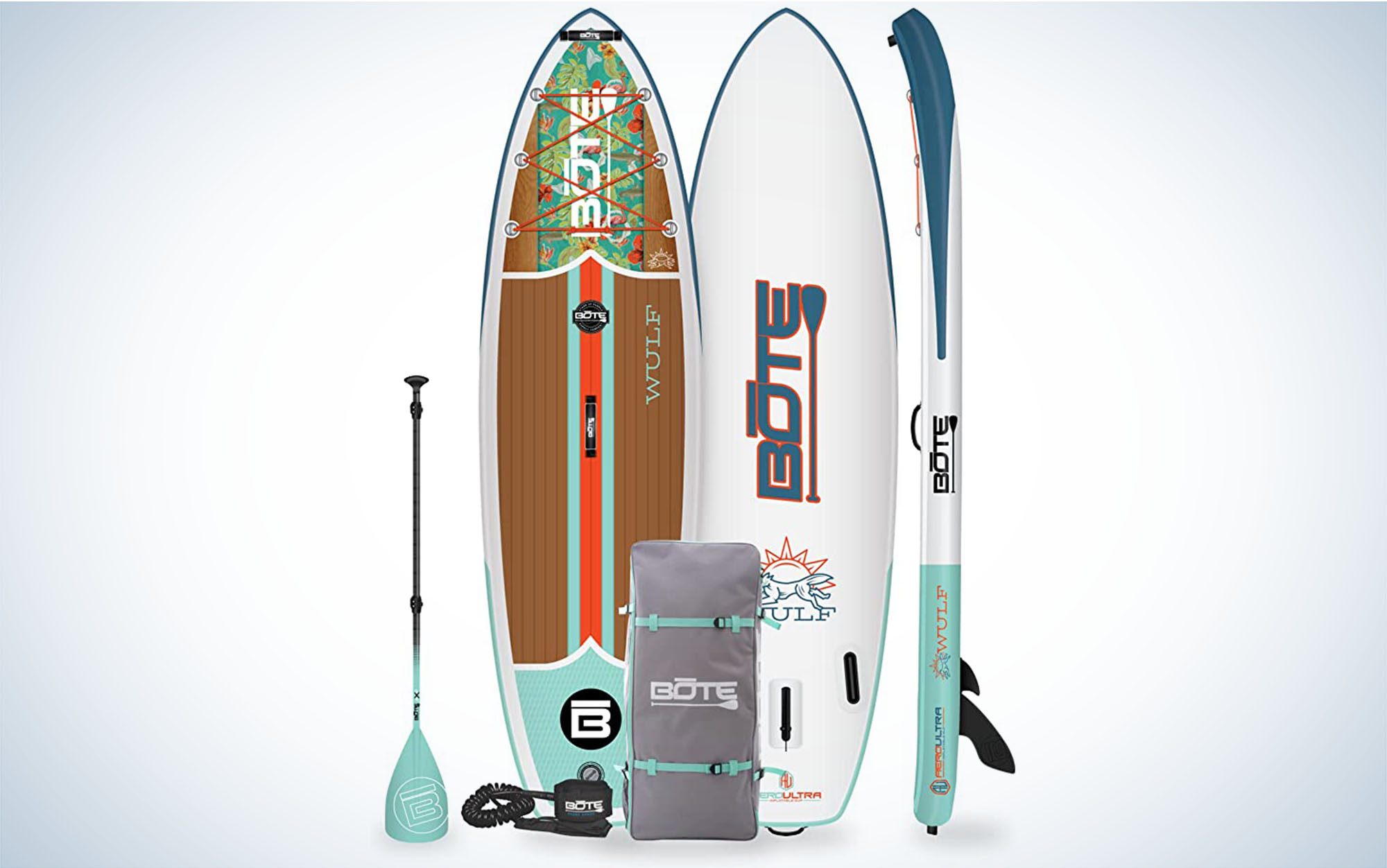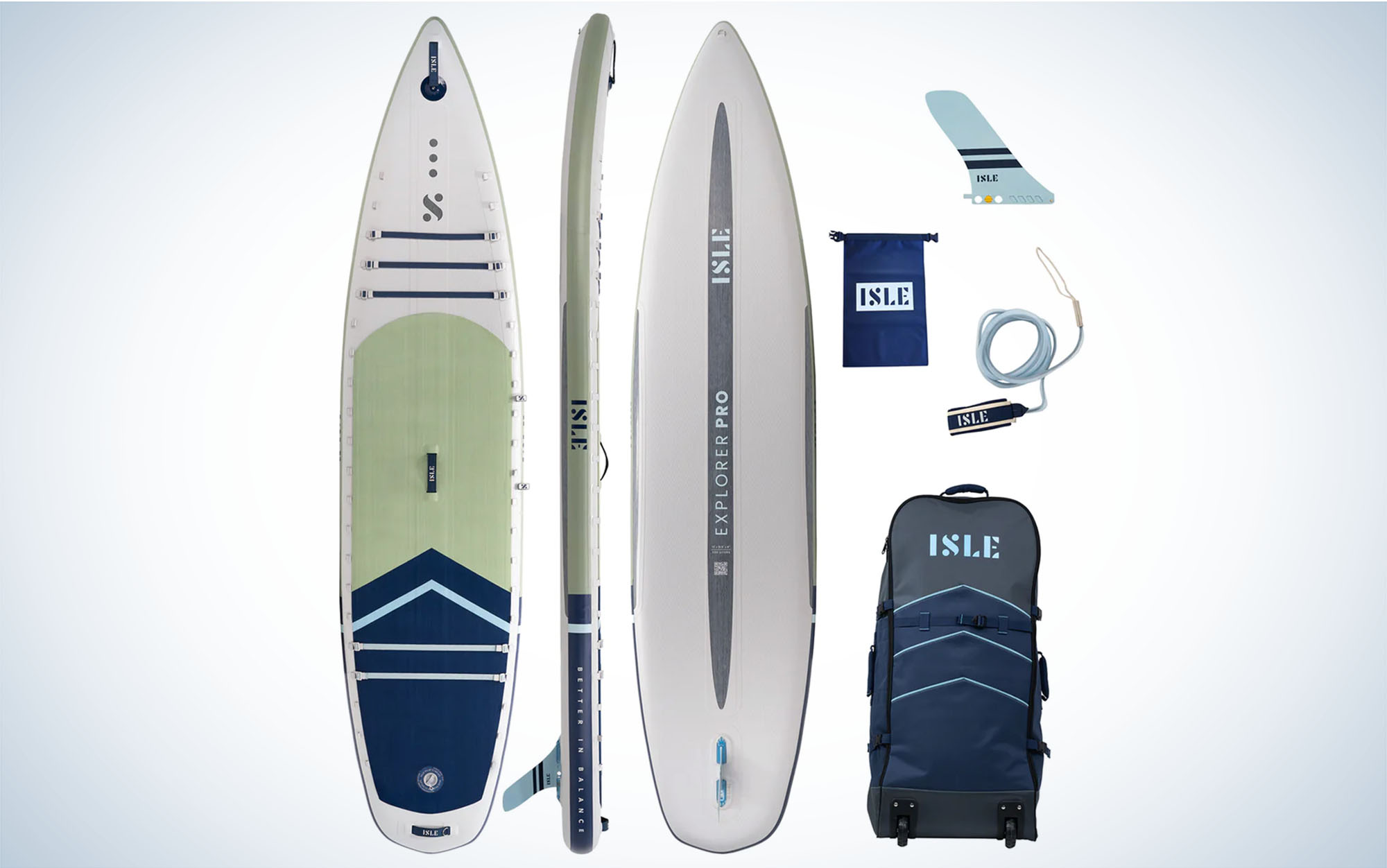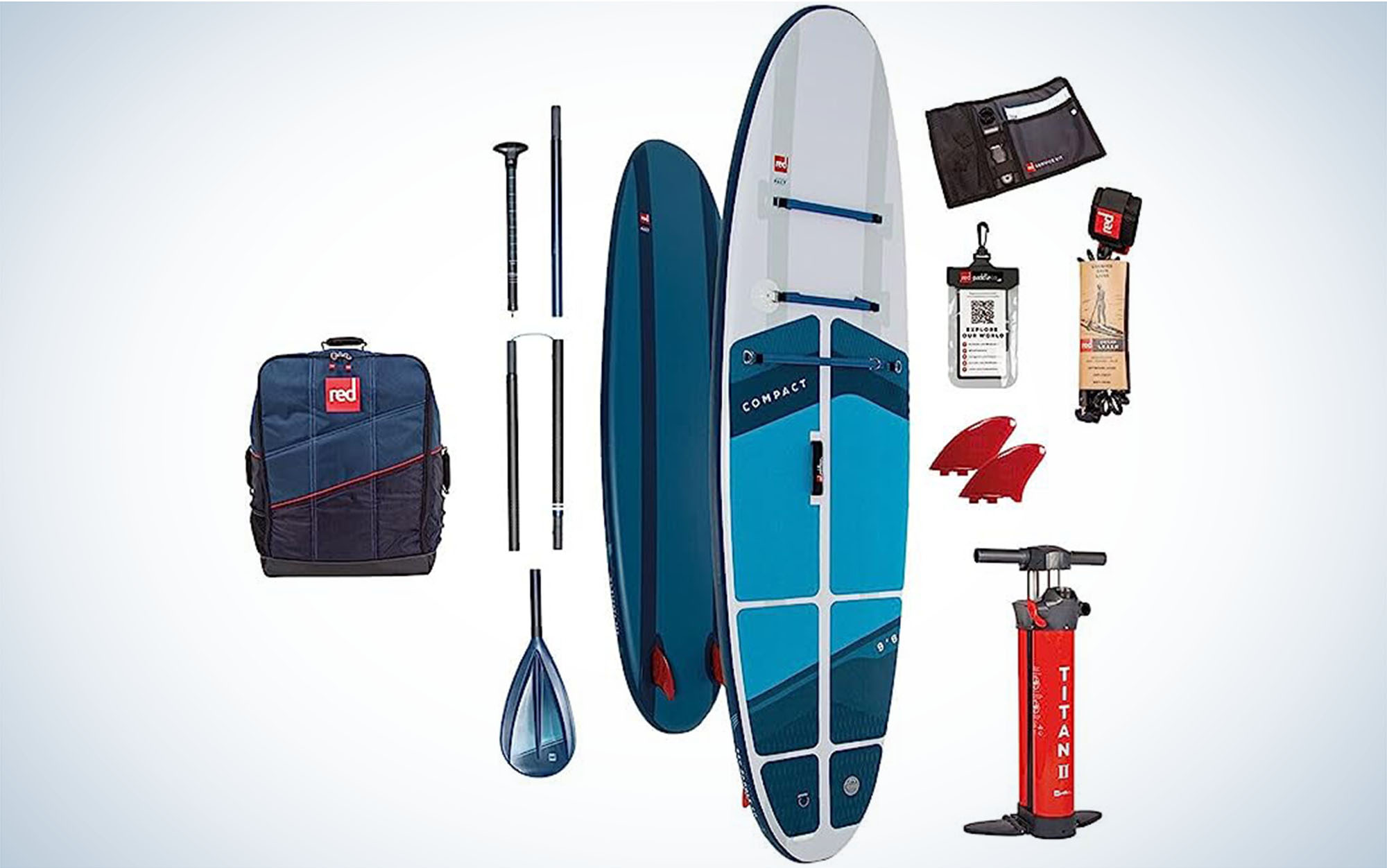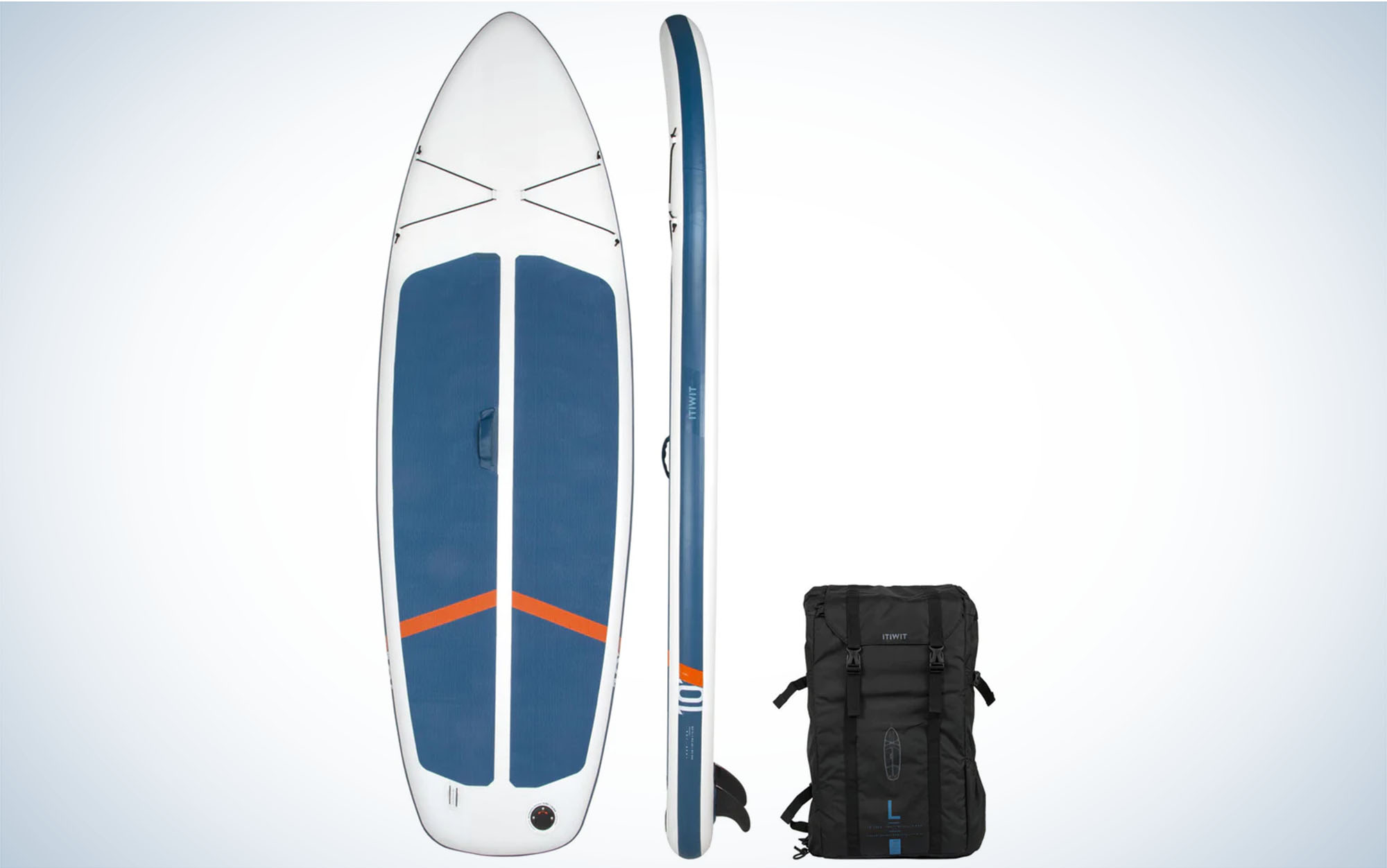We may earn revenue from the products available on this page and participate in affiliate programs. Learn More ›
Published Jun 29, 2023 3:30 PM
It’s not just you: seemingly everyone these days is on an inflatable paddle board. If you’re considering making the plunge yourself, you might wonder how to choose a SUP. With so many brands to choose from and a (very wet) learning curve in front of you, it can be hard to know if you should grab a discount board from Walmart or invest in something more substantial. To help you find the best inflatable paddle board for your needs, we checked out models from Isle, Bote, Decathlon, iRocker, and Red Paddle.
How I Tested the Best Inflatable Paddle Boards
My test of the best inflatable paddle boards took me from flat water lake paddling to the more tumultuous waters of Puget Sound to mild whitewater paddling along the Colorado River in southern Utah. While I started as a beginner SUP user, by the end of testing, I was confident enough to head out for an hour or more in various conditions. This review focuses on paddle boards that are appropriate for beginner and intermediate paddle boarders, and it is less focused on boards that are appropriate for multi-day adventures or racing.
I assessed the paddle boards on several criteria, including ease of setup and takedown (including inflating with the provided pump), packed size, portability (both packed and unpacked), stability, tracking (how easily a paddle board kept to a straight line), and versatility as I moved from a seated to a kneeling to a standing position and then back again. Finally, I considered price and warranty (all paddleboards tested had a minimum warranty of two years).
Best Inflatable Paddle Boards: Reviews & Recommendations
Best Overall: Isle Switch
Key Features
- Available Lengths: 11.5 feet
- Weight: 19 pounds
- Weight Limit: 425 pounds
- Also includes a backpack, hand pump, paddle, kayak seat, and foot brace
Pros
- Very stable
- Kayak conversion makes for a more versatile setup
- Linking system allows for a variety of configurations
- Lightweight for its size
- Very high weight limit
Cons
- Somewhat complicated fin system
If your primary objective with your standup paddleboard is having a good time, then the Isle Switch is the paddleboard for you. It was the most versatile paddleboard I looked at, and was equally fun no matter what I was doing: standing, sitting, in kayak mode, in tandem mode, on flat water, in mild rapids.
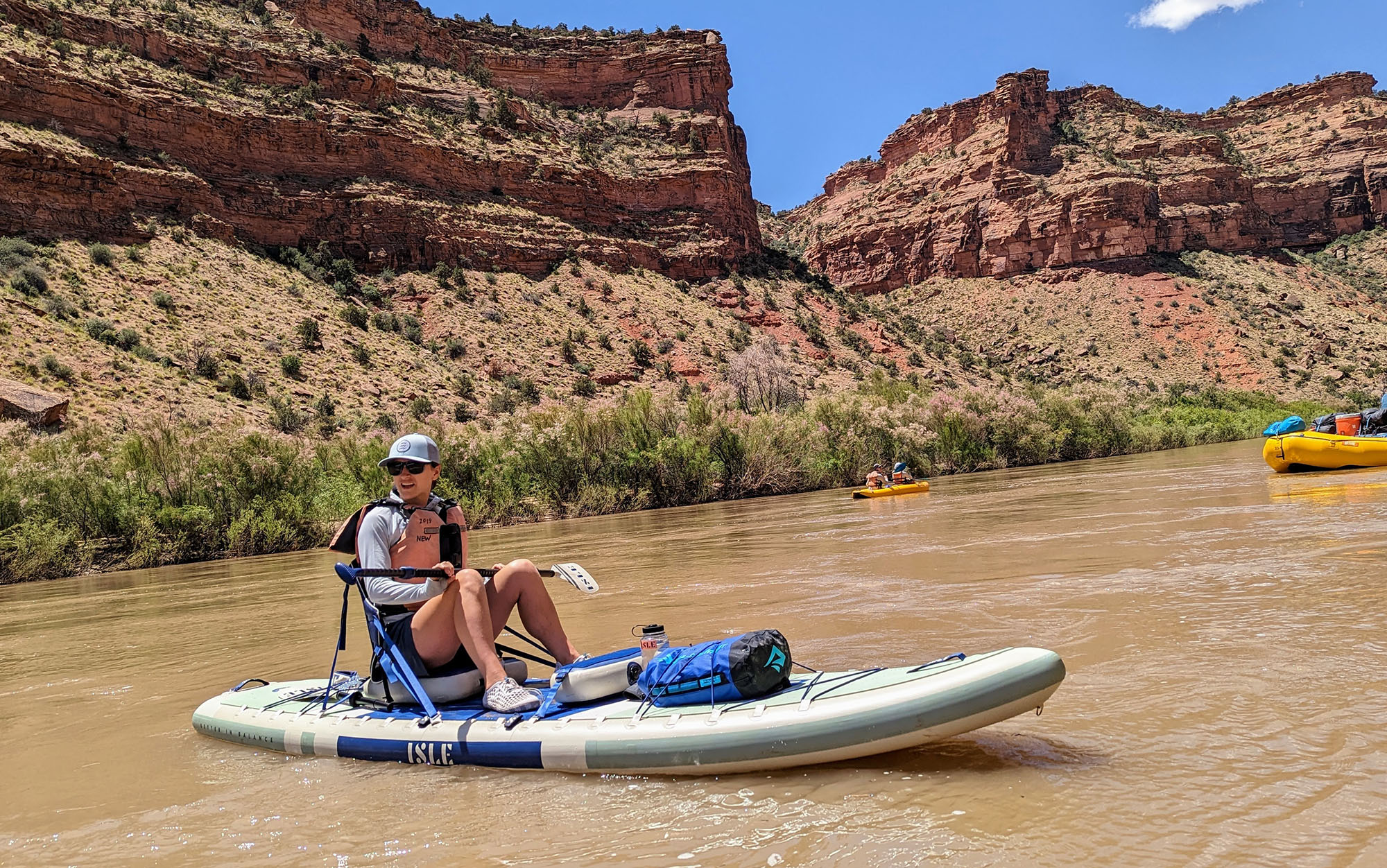
Sam Schild
At 35.5 inches, the Isle Switch was the widest board I looked at. With its 6 inches of height, it ends up being a larger volume board, which massively improves its stability, despite being on the lower side of the PSI range.

The first time I stood up on this board I was in the middle of the fast-flowing Colorado River, and I was surprised at how stable I felt, even as small eddies and currents tipped the board. What was even more impressive is that this stability didn’t come with a major weight penalty: at 19 pounds, the Isle Switch is fairly light.
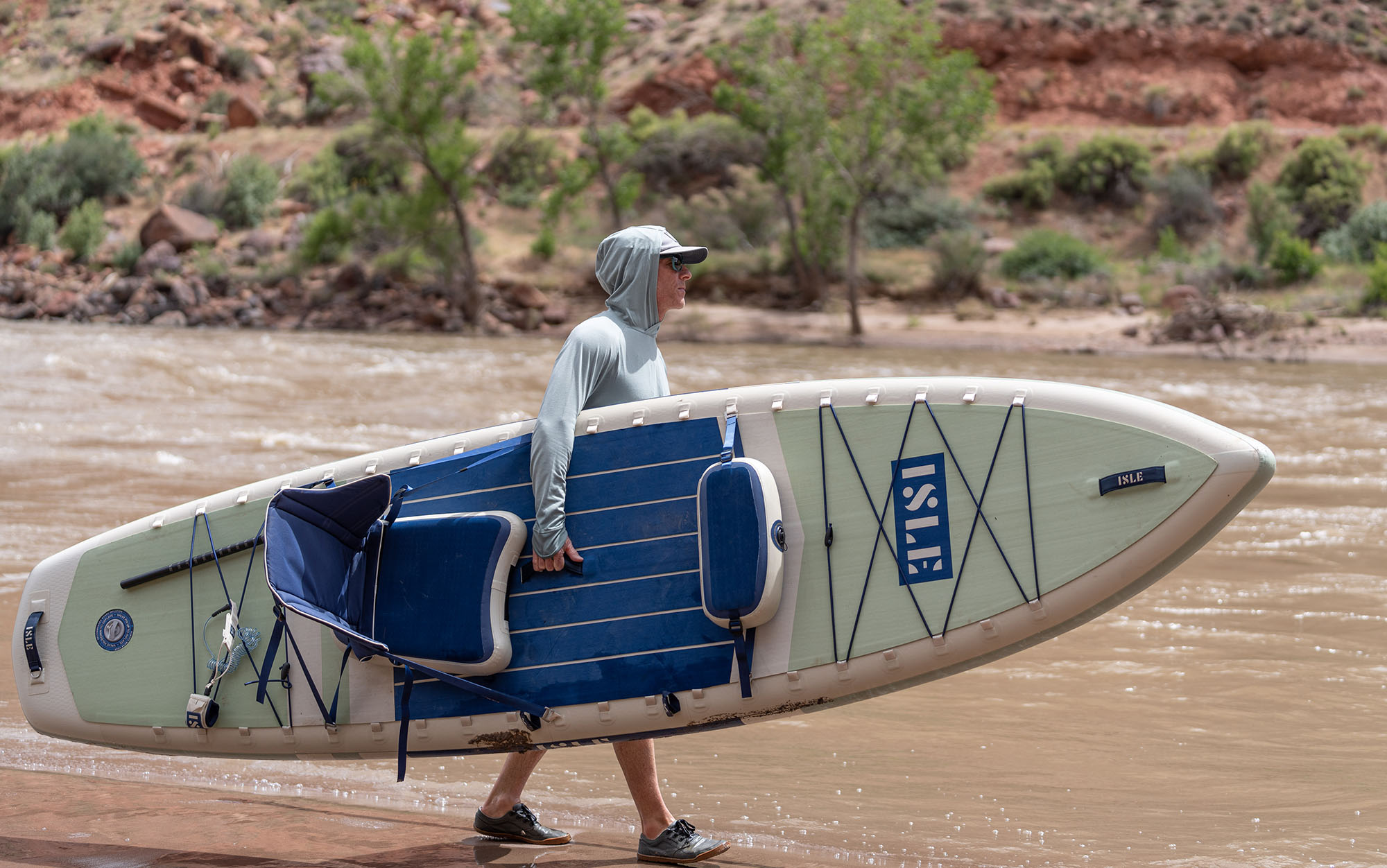
I didn’t stay standing for too long because the Isle Switch has a kayak mode. By adding a seat and footrest, you can convert your inflatable paddle board to a sit-on-top kayak. While not quite as stable as the best sit-on-top kayaks, it is plenty stable enough for flat water and was an absolute blast to ride through some mild rapids on the Colorado River.
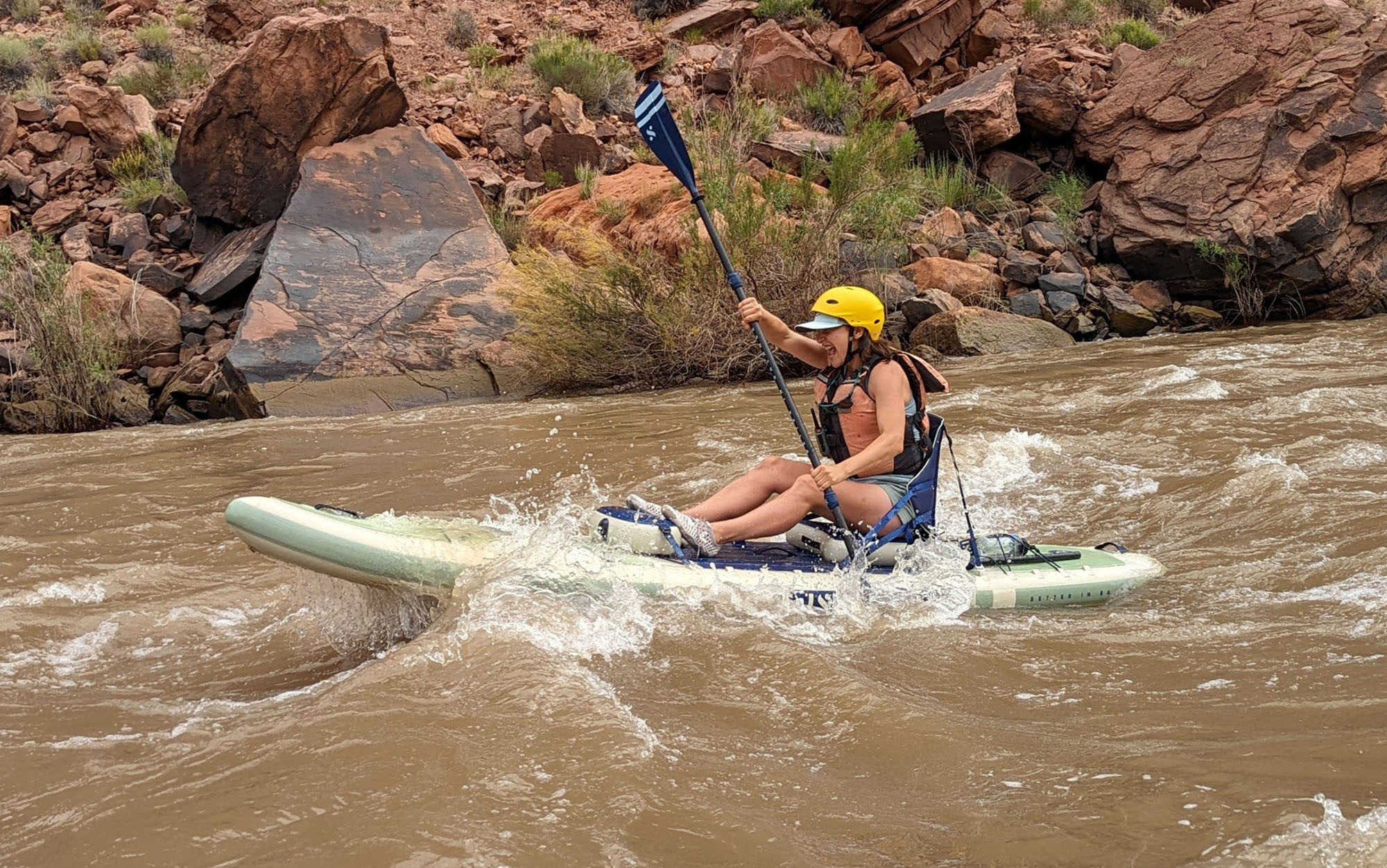
A nice feature of the Isle Switch is its linking system, a series of connection points running up the entire length of each side of the standup paddle board. This allows for maximum customization with the kayak seat—no need for taller folk to scrunch up their legs—as well as a wide range of other configurations, including creating a tandem sit-on-top kayak or even connecting multiple SUPs together for the ultimate party boat.
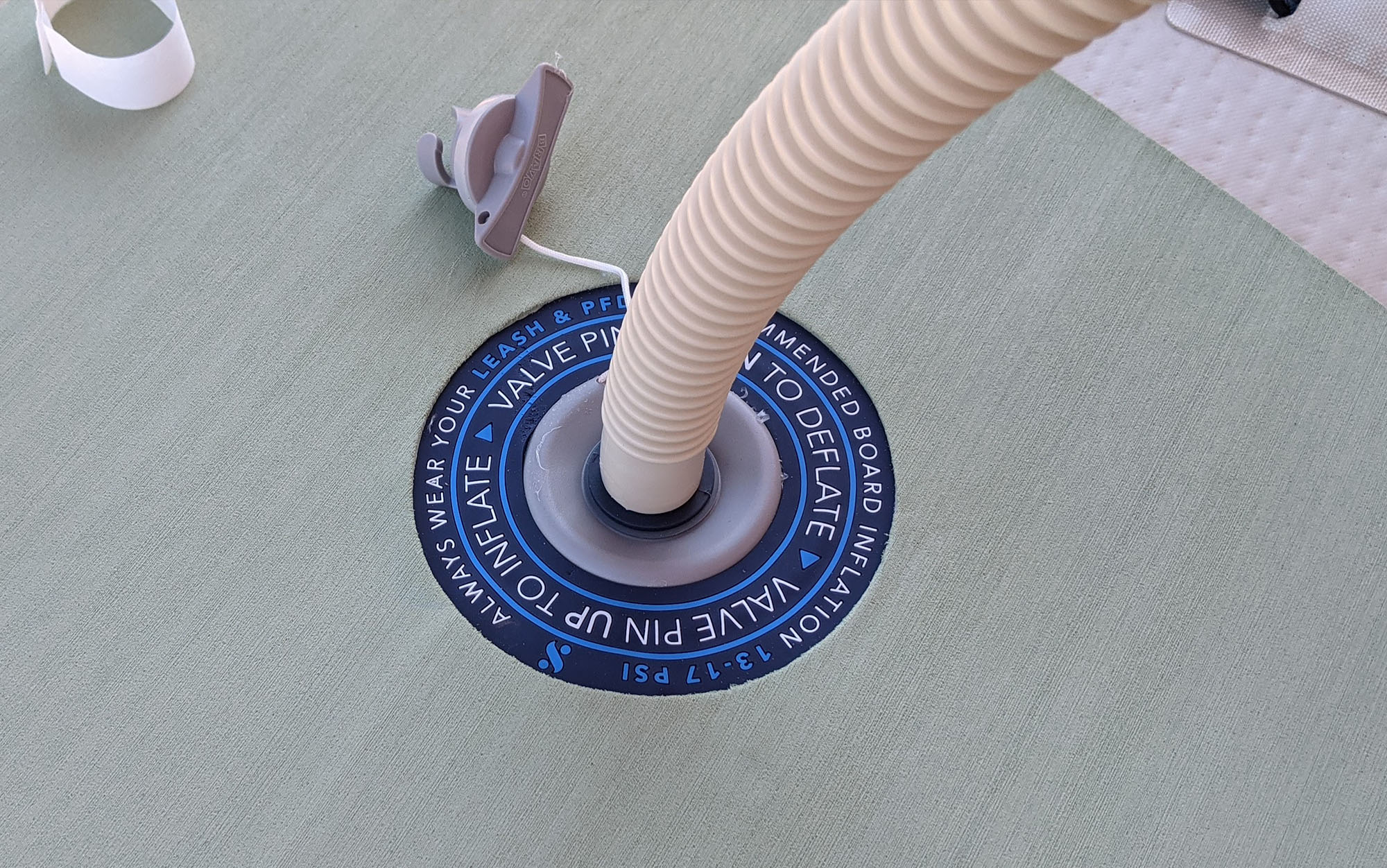
The only somewhat tricky part about this otherwise straightforward board was its fin design. Isle provides you with two ways to install the fin, one with a super bolt pin and one with a small knob insert. The former is more complicated to install than other options I looked at, and the latter requires more force to secure into place. However, both work just fine and are only minor considerations if you plan to leave your SUP inflated for the duration of the season.
Easiest Setup: iRocker Cruiser Ultra 2.0
Key Features
- Available Lengths: 10.5 feet
- Weight: 21 pounds
- Weight Limit: 300 pounds
- Also includes a backpack, electric pump, and paddle
Pros
- Electric pump makes setting up and taking down this paddleboard a breeze
- Oversize bag easily fits all accessories and parts
- Paddle and fins are easy to assemble
Cons
- Slightly less stable than my best overall pick
- Fewer add-on features than my best overall pick
After a month of testing inflatable SUPs, I was getting pretty tired of inflating and deflating the paddle boards over and over again. At one point, I even started just leaving the one I was testing set up in the hallway of my apartment building (until I got a text from my building manager to knock it off). A glimpse next door revealed how my neighbors were handling this dilemma: they were just leaving their paddleboards inflated out of doors.
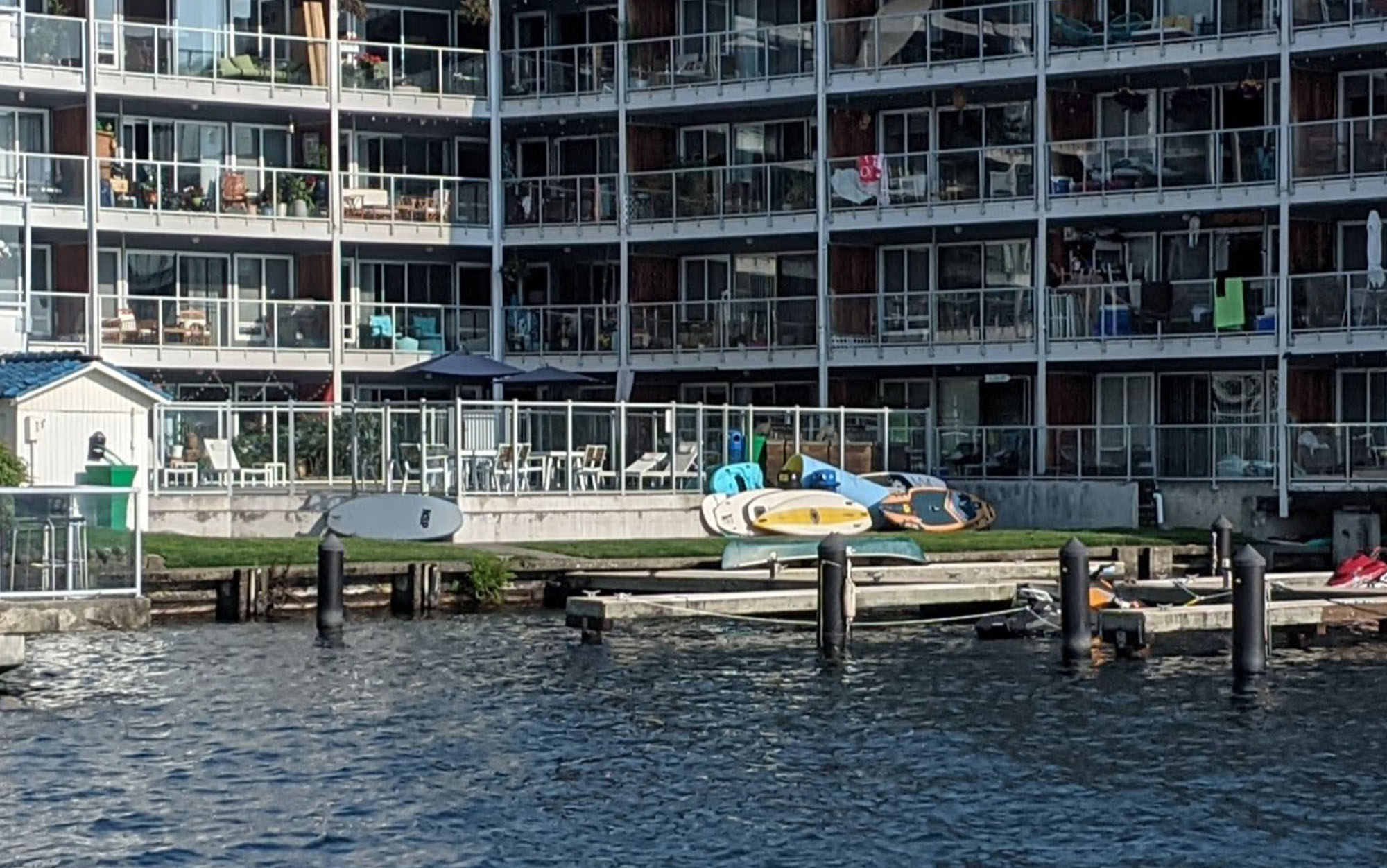
Leaving your paddleboard inflated long-term is typically fine; however, leaving it inflated in the sun is not. That’s because the heat can actually cause the internal PSI of your paddleboard to increase—if that happens too much, your inflatable paddle board will burst.
So I was relieved when I opened the box of the iRocker Cruiser Ultra 2.0 and found that it came with an electric pump instead of a hand pump. This thing is a game changer. Instead of struggling to move the needle on the PSI reading from 5 to 7 while pumping by hand, I could spend the time assembling my paddle, putting on my life vest, and just chilling. Even better, the electric pump was so small that it fit directly into the generously sized carrying case for the iRocker Cruiser Ultra 2.0.
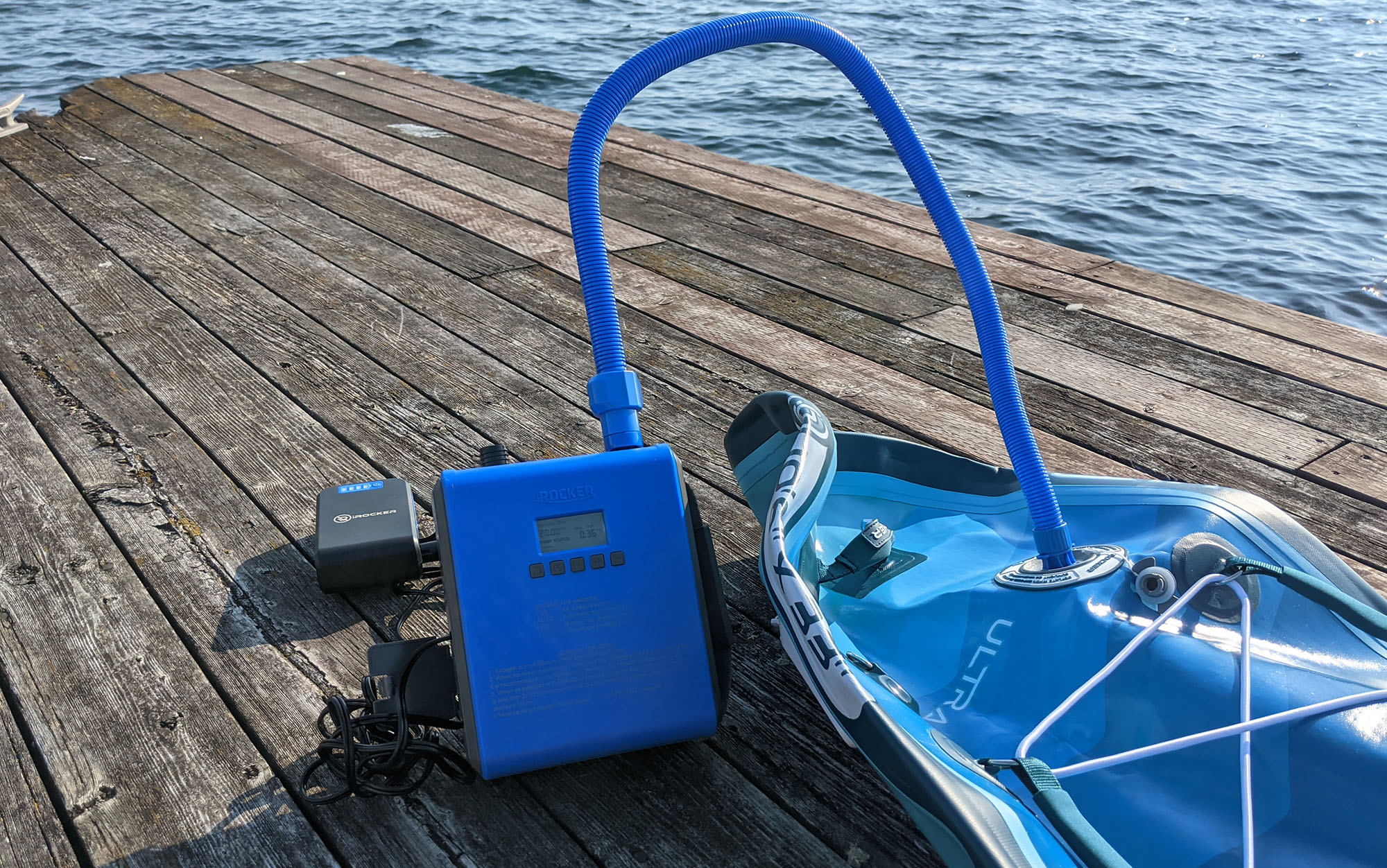
While the pump is small, it does not come with its own power source; instead it is designed to be plugged into the cigarette lighter port of your car. It would be nice if this pump came with an integrated battery, or if it could be plugged into a USB-C or even AC outlet (which are more common on the best power banks). However, iRocker sells a battery to use with this pump that is small and convenient.
The rest of the iRocker Cruiser Ultra 2.0 setup was similarly easy, with the paddle snapping together quickly, and clear attachment points for both the fins and the ankle strap. All this meant that my experience actually using this SUP—which at 33 inches had plenty of stability for even windy lake conditions—was much improved.
Typically, most paddleboarders last about a season with a hand pump before upgrading to an electric pump; I say, why wait? If you’re not planning to leave your paddleboard inflated all summer long, then the iRocker Cruiser Ultra 2.0 will provide you with one of the better experiences.
Best Value: Bote Wulf Aero
Key Features
- Available Lengths: 10.4 feet
- Weight: 20 pounds
- Weight Limit: 250 pounds
- Also includes a backpack, hand pump, and paddle
Pros
- One of the more affordably priced options I looked at
- Very stable for its size
- Colorful design
Cons
- Kind of slow and poky
- Surface is somewhat less comfortable to stand on long-term in bare feet
- Somewhat lower weight limit
If you’re looking for one of the best inflatable paddle boards for beginners, the Bote Wulf Aero is one of the best values you’ll find. It’s a high-quality SUP that’s very stable and easy to use—you’ll be hooked on paddle boarding after a few afternoons on this one. It’s also fun, with some of the best color and design options of anything I looked at. Even better: it’s half the price of my best overall pick.
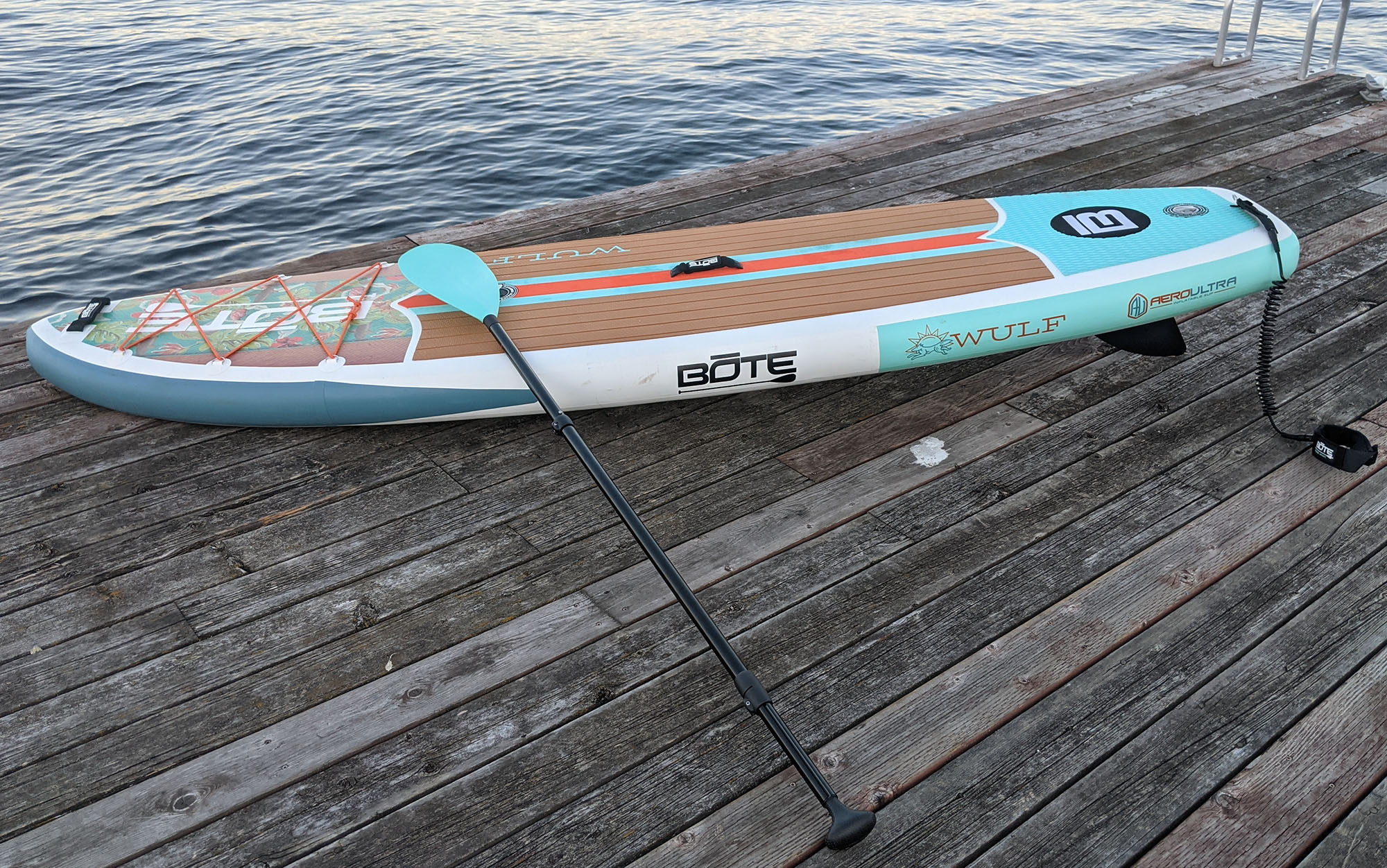
The stability of this board was so top notch that I ended up paddle boarding over a mile the first time I took it out. Whereas with other boards, I frequently feel the shake in my legs start to creep up after 20 minutes or so on the water, after an hour of paddle boarding with the Bote Wulf Aero they still felt fresh. Which was great, because I wasn’t getting to my destination terribly fast. While this board tracked well, even on a day with a strong breeze, it wasn’t as fast as other SUPs I tried for this test.
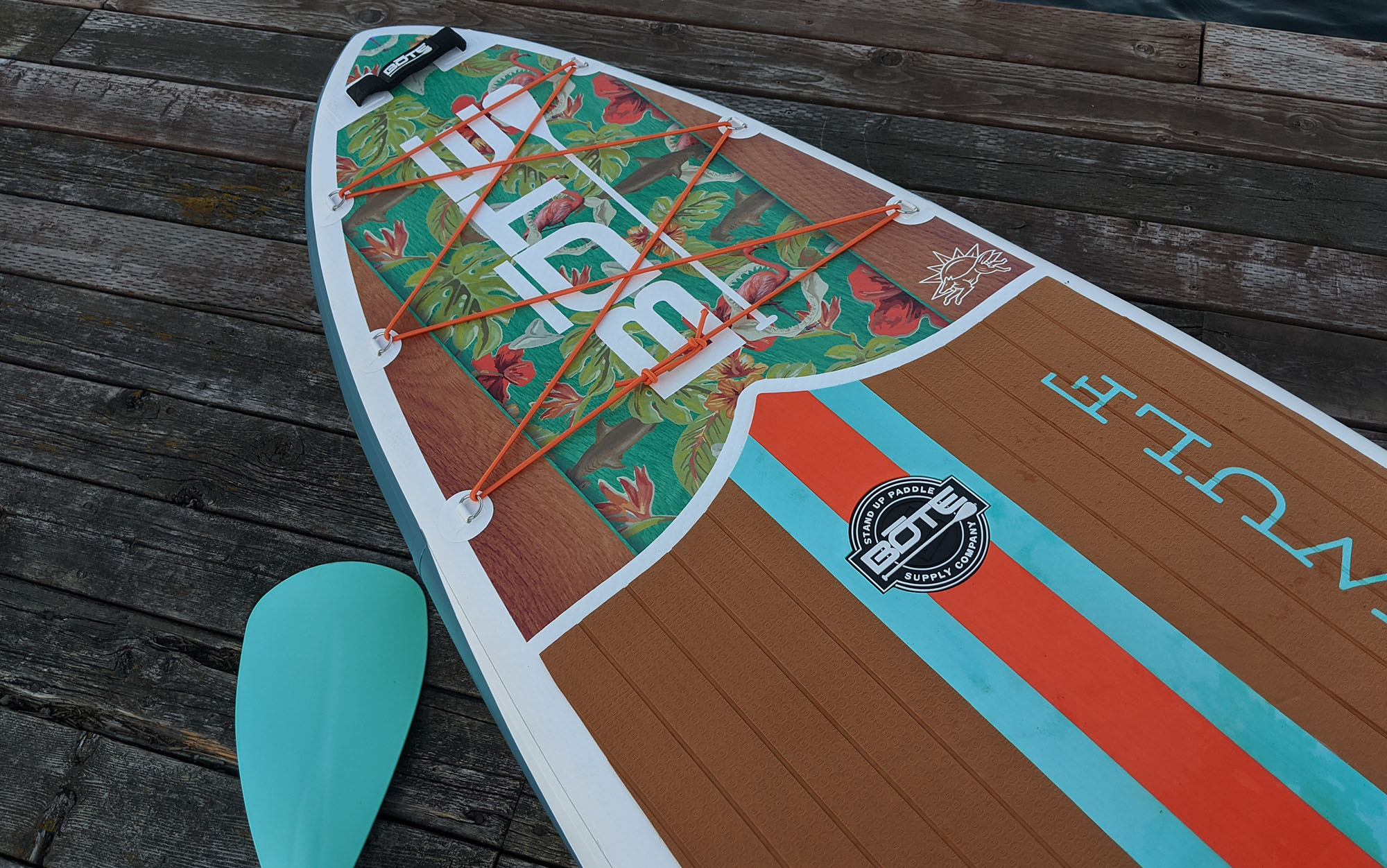
I also found that the slight indents on the deck of the SUP started to bother my feet, which wasn’t an issue with inflatable paddle boards with smoother decks (note that you won’t notice this detail if you SUP in shoes or sandals). If you’re touring, these quibbles might mean you look at a different board; if you’re just trying to get into the middle of the lake to chill with your friends, it’s a non-issue. Get this one to start your paddle boarding journey, and then plan to hand it down to your kid when they’re ready to join you out on the water.
Best Upgrade: Isle Explorer Pro
Key Features
- Available Lengths: 12 feet and 14 feet
- Weight: 23 and 27 pounds
- Weight Limit: 325 and 375 pounds
- Also includes a backpack
Pros
- Quite stable for its comparatively narrow width
- Faster than other boards I looked at
- Four-year warranty
- Fewer seams mean that the long-term odds of leaks are reduced
Cons
- Doesn’t come with a paddle or pump
If you’ve already got one of the best inflatable paddle boards and are looking to upgrade, you have a couple of directions you could go. You could get something with lots of accessories: kayak seats, tandem seats, electric pumps, rod holders, coolers. Or you could start increasing your distance, and your speed.
If the latter sounds more appealing to you, then the Isle Explorer Pro would be a great option for your paddle board upgrade. It was the longest, narrowest, and most rigid inflatable paddle board that I tried and the difference in speed and smoothness was immediately apparent. But despite the comparative lack of volume, this was still a surprisingly stable SUP—I didn’t fall off once.
While the Isle Explorer Pro also comes with the linking system, if you’re looking to upgrade to a kayak setup or tandem setup, you’ll likely be happier with the roomier and even more stable Switch.
Note that this paddle board doesn’t come with a paddle or pump as the assumption is that you either already own these or that you would prefer the option to customize your purchase rather than have it included as a package.
Most Portable: Red Paddle Compact MSL Pact
Key Features
- Available Lengths: 9.5, 11, and 12 feet
- Weight: 16.3, 20, and 22.4 pounds
- Weight Limit: 210, 240, and 265 pounds
- Also includes a backpack, hand pump, and paddle
Pros
- Best carrying case of anything I looked at
- Great tracking for its size
- Best hand pump I used
Cons
- High recommended PSI is hard to get to with a hand pump
- Very expensive
Having written thousands of words about backpacks, everything from the best ultralight backpacks to the best hiking daypacks, I’m here to say that most of the photography of SUPs at remote pristine mountain lakes is misleading. I could not carry most of these more than a hundred feet without discomfort, let alone miles into the backcountry. It’s not even that they are heavy; the backpacks just aren’t designed well enough to do more than get you from your car to the beach.
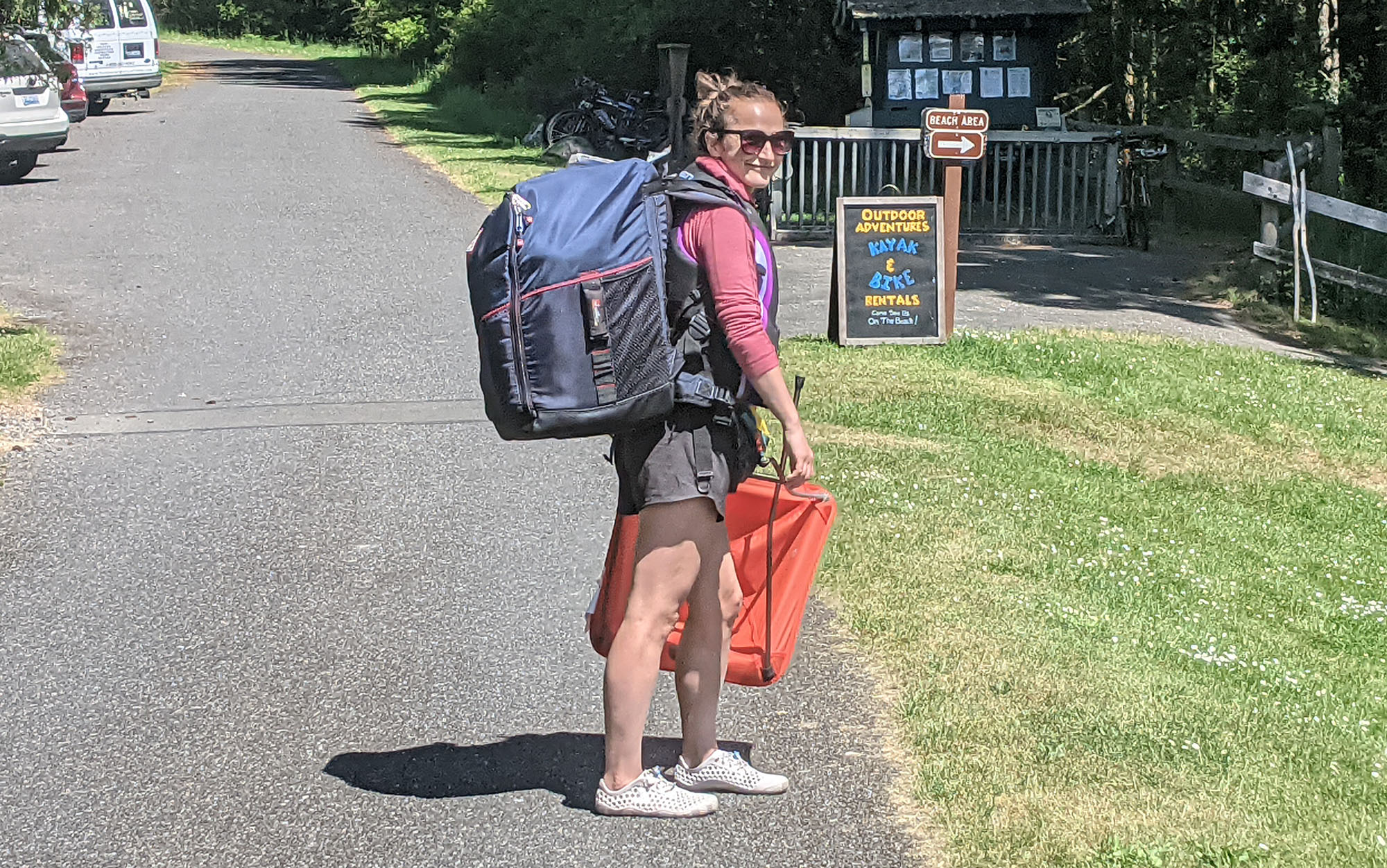
The one exception to this is the Red Paddle Compact MSL Pact. Compared to the others, this backpack distributed weight well, was comfortable on my shoulders, and fit everything securely inside. It even has some lower back padding that helps to keep the weight from settling too much on your shoulders. It’s not a perfect backpack, but it is doing the work of a true load hauler. It’s even well-organized, with straps on the interior for each paddle segment (stenciled drawings show you which one fits where), and zip pockets for the fins and repair kit. And the shape of the backpack is designed to fit the paddle board rolled around the handpump. It’s a well-thought-out design.
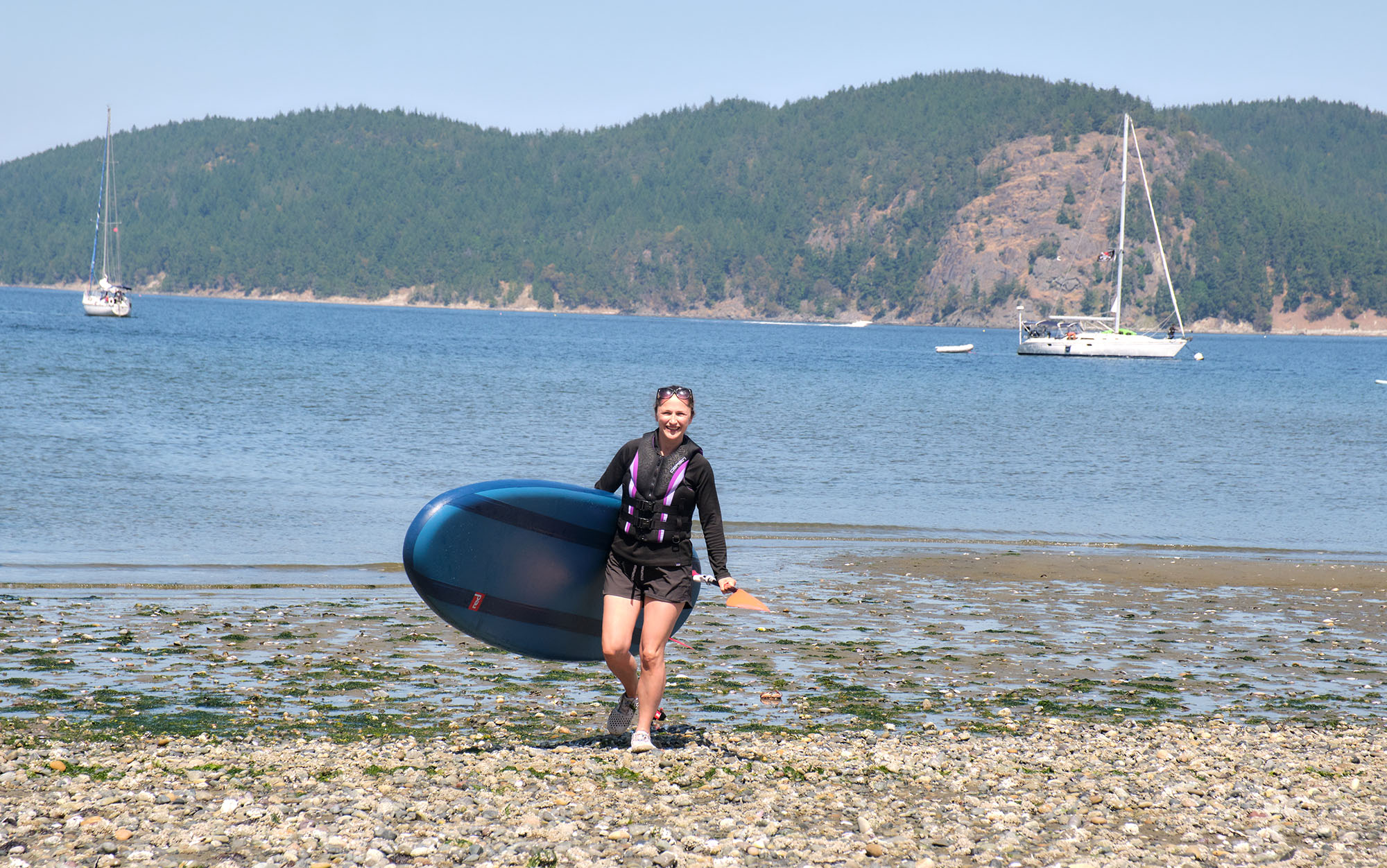
During testing I noted that, for its size and shape, the Red Paddle Compact MSL Pact had outstanding tracking, even in the stiff current off Spencer Spit State Park on the San Juan Islands. In many ways it handled like a SUP a foot longer than it was while still packing down into a surprisingly small size.
The last thing to note is that this was far and away the most expensive paddleboard I looked at. If you don’t dream of hiking into a remote paddleboard destination, then I’d recommend checking out the Bote Wulf Aero or the Isle Switch over the Red Paddle Compact MSL Pact.
Smallest Packed Size: Decathlon Itiwit Adult Ultra Compact
Key Features
- Available Lengths: 8 feet, 9 feet, and 10 feet
- Weight: 13.2 pounds, 15.4 pounds, and 17.6 pounds
- Weight Limit: 130 pounds, 175 pounds and XXX
- Also includes a backpack
Pros
- Affordable
- Very small packed size
Cons
- Paddle and pump must be purchased separately
- Showing some signs of wear and tear
- Worst tracking in my test
- Low weight limit
While obviously more space-effective than hardboards, inflatable paddle boards still take up a surprisingly amount of room when stored away. If space in your life is at a premium, then it’s worth looking at the petite Decathlon Itiwit Adult Ultra Compact. While other inflatable paddle boards came with a backpack, the Decathlon was actually backpack-sized: you’ll definitely be able to squeeze this one into the back of your mid-sized SUV.
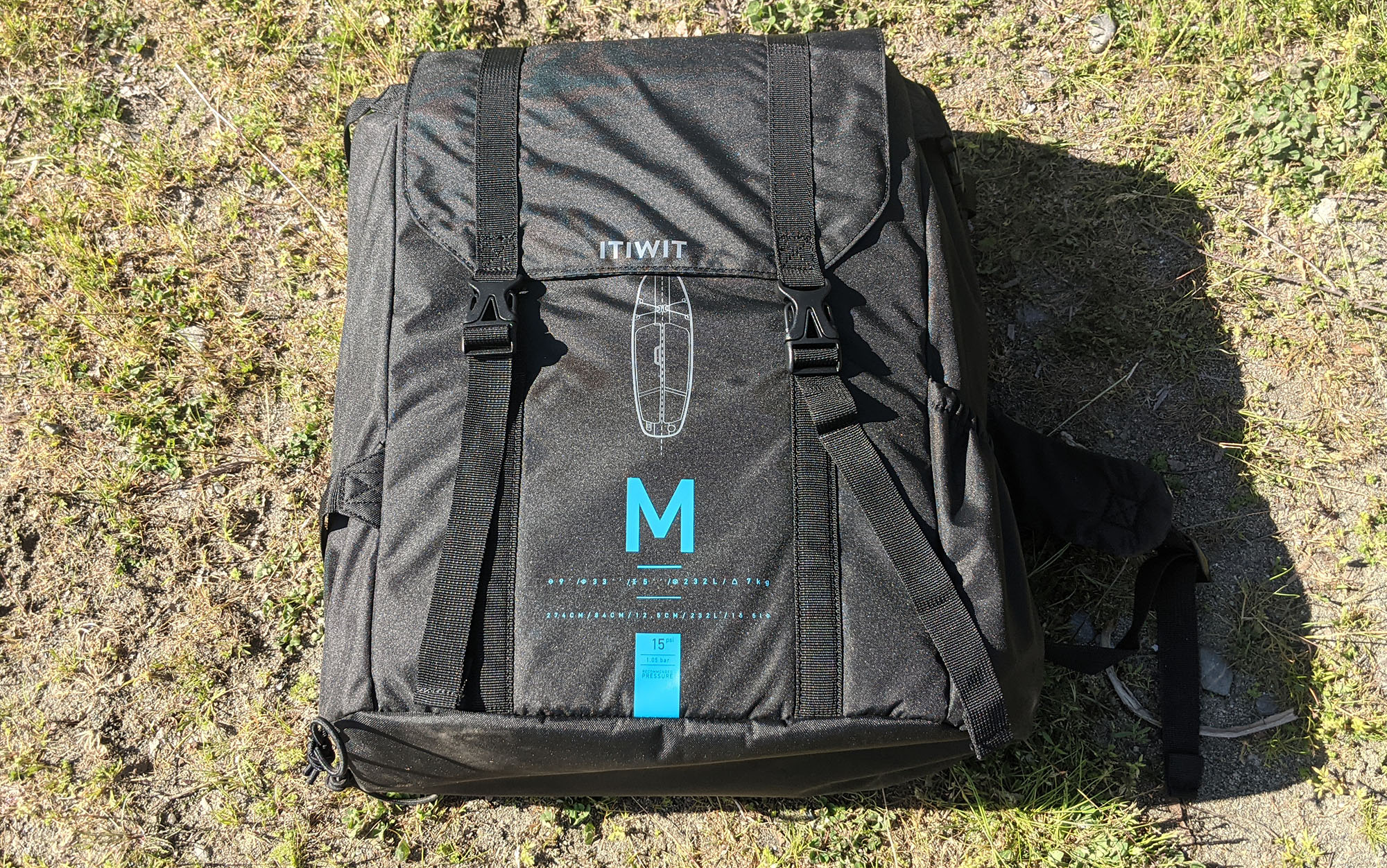
Of course, that space-saving comes at a cost: the paddle and the pump are not included in this package, so they’ll need to be purchased and squeezed into your rig separately. This was also not the highest performing standup paddle board I looked at: the tracking noticeably lagged during testing, and there are more visual scuffs on it after moderate use than others I’ve tested.
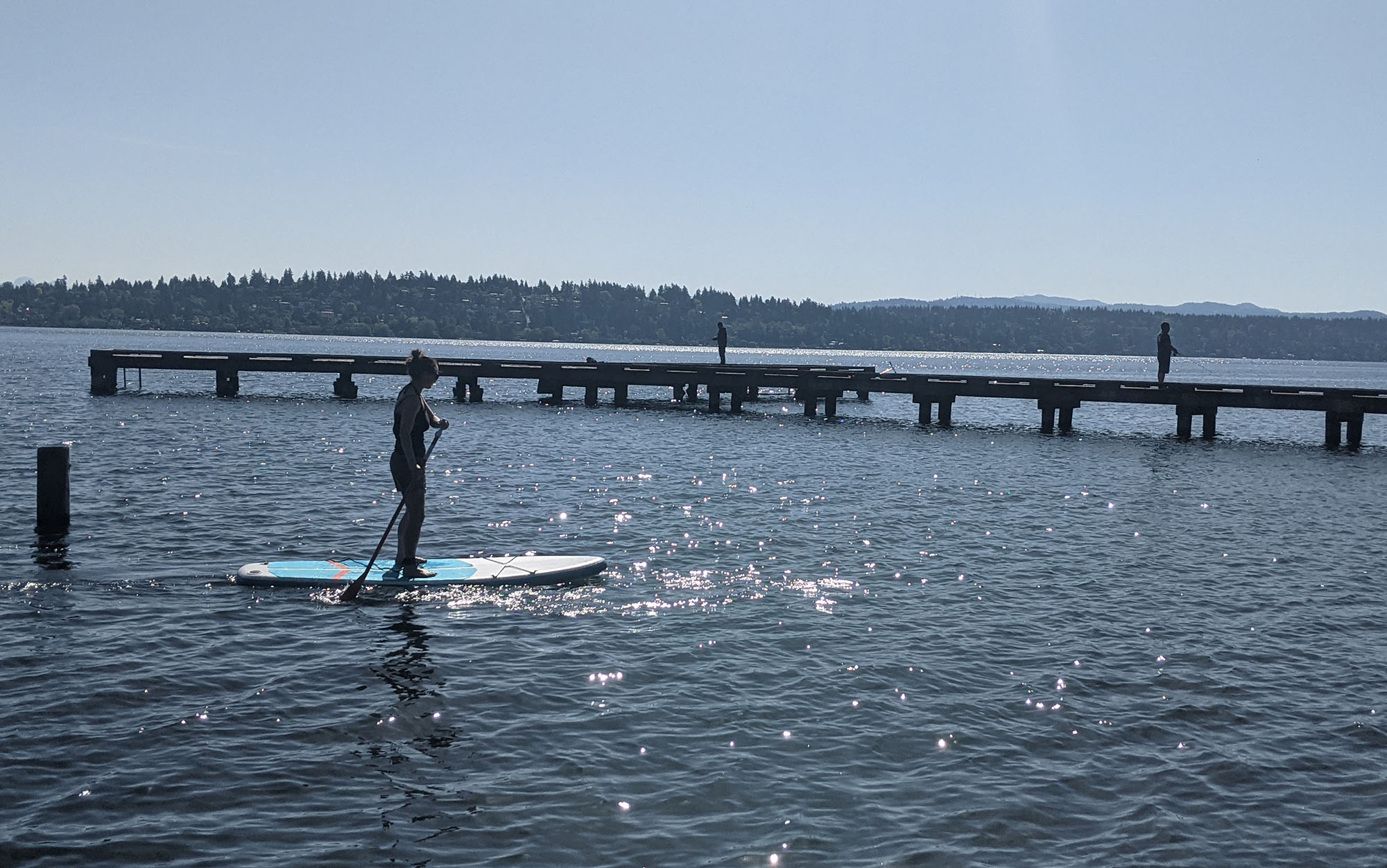
But that being said, this is a very affordable paddleboard. Snag this one if you’re unsure how often you’ll get out there and don’t want your paddleboard taking over your gear closet.
How to Choose an Inflatable Paddle Board
Inflatable Paddle Board Length and Width
As a fairly short person with a low center of gravity, I could test fairly short (in the 10-foot range) inflatable paddle boards without too much difficulty. But if you are on the taller end of the spectrum, you’ll want to opt for a board that is both longer and wider—aim for twelve feet if at all possible.
Inflatable Paddle Board Weight
Because I am a smaller person, some of the larger and longer boards I tested were sometimes difficult for me to maneuver around. The exception to that was the lightweight Isle Switch. If you expect to be walking a long distance with an inflated board, look for something on the lighter end of the spectrum to maximize its maneuverability.
Cost
Inflatable paddle boards can range in cost from as little as a couple of hundred dollars to over two thousand dollars. But, as with other high-end pieces of gear, you get what you pay for. Consider your aspiration level (do you plan to head out for several miles of paddle boarding at a time, or do you just want to lounge a few hundred feet offshore?) and budget before making a final purchase.
Accessories
While plenty of serious paddle boarders use inflatables, there are also plenty of reasons to invest in one for more casual reasons—or even as part of another sport, like fishing. When choosing your inflatable SUP consider the different activities you’d want to do with it and choose a board that is compatible with the different accessories you’d choose for that purpose.
Hand Pump or Electric Pump
After pumping up and deflating several inflatable paddle boards by hand, I’m here to say it can be done. Even by a person of average strength.
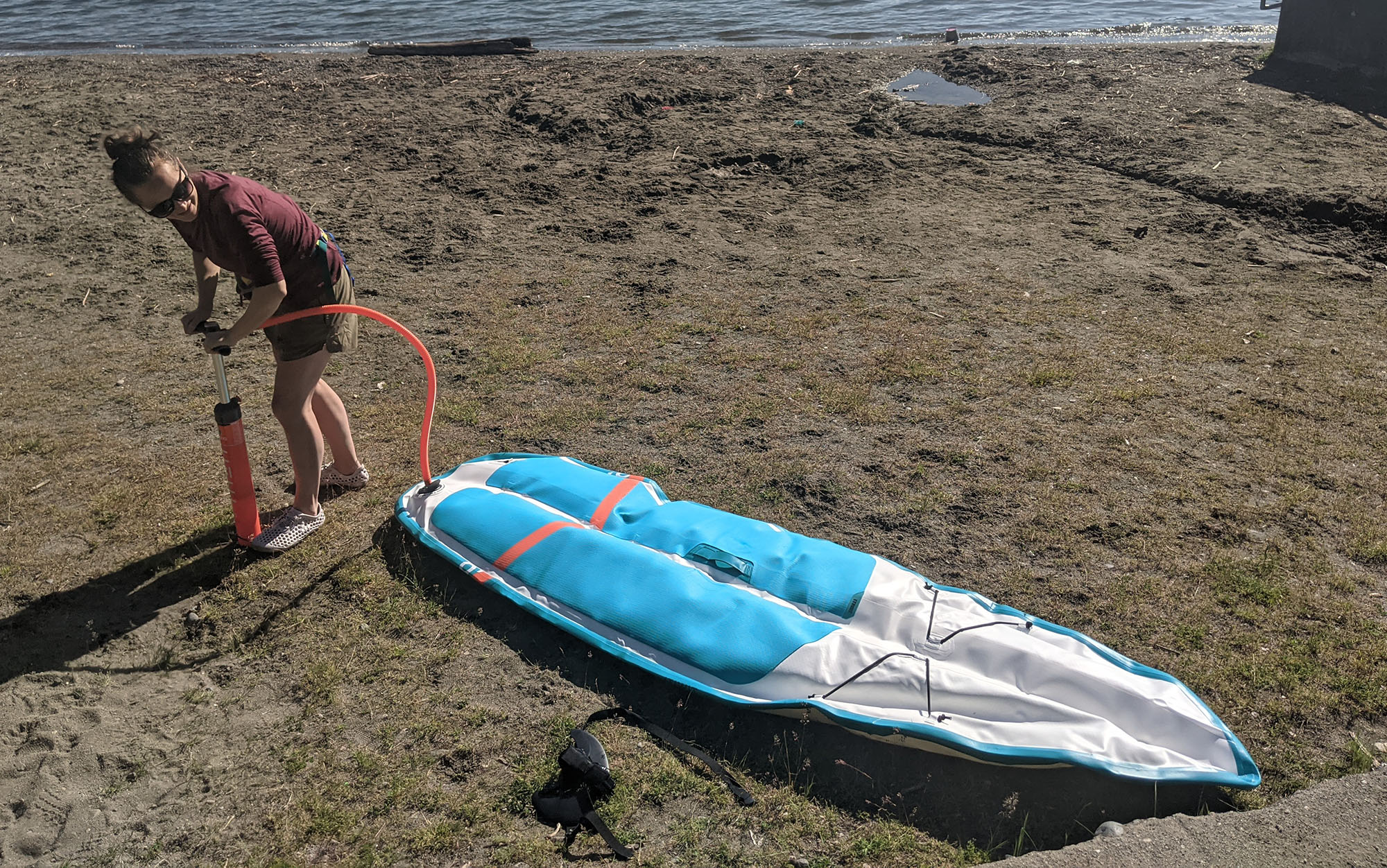
But you don’t want to. I recommend investing in an inflatable paddleboard pump—and a portable power unit that is compatible with it, so you don’t have to lug the inflated board from your car to the beach.
FAQs
Q: Can I leave my inflatable SUP outside?
You can leave your inflatable SUP outside, but try to avoid leaving it in direct sunlight, especially if it’s a darker color. As SUPs heat up, the internal PSI can increase. If it increases too much, the SUP can explode.
Q: Are inflatable paddle boards worth the money?
Inflatable paddle boards are definitely worth the money: significantly easier than surfing and way more fun than sit-on-top kayaks. Whether you are looking for new ways to enjoy the outdoors or just to add a new activity to your car camping routine, it’s hard to go wrong with an inflatable paddleboard.
Q: Should I roll or fold an inflatable SUP?
While rolling is generally going to help extend the life of your SUP, in practice they tend to fold even when you are trying to roll them. To avoid this you can try rolling your inflatable paddle board around the hand pump it came with.
Why Trust Outdoor Life?
Since 1898, OL has been a leading authority in testing and reviewing hunting gear, fishing tackle, guns and shooting equipment, and much more. We have more than a century-long history of evaluating products, and we’re now bringing that expertise to online reviews. Our editors are experienced outdoorsmen and women, and most importantly, we’re trained journalists. We prioritize field testing and objective data when reviewing products. We conduct interviews with gear manufacturers and engineers as well as outdoor experts so that our readers have an understanding of how and why a product works—or doesn’t.
Advertising does not influence our gear reviews and it never will. While we always focus our coverage on standout products—because we want our readers to be aware of the latest and greatest gear—we also cover the flaws and quirks of any given product.
Final Thoughts on the Best Inflatable Paddle Boards
If you’re ready to jump on the inflatable paddle board train (you won’t regret it), there are a number of great SUPs to choose from at a wide range of price points. We’ve rounded up some of our favorite picks here and described what use we think each board is best for.

